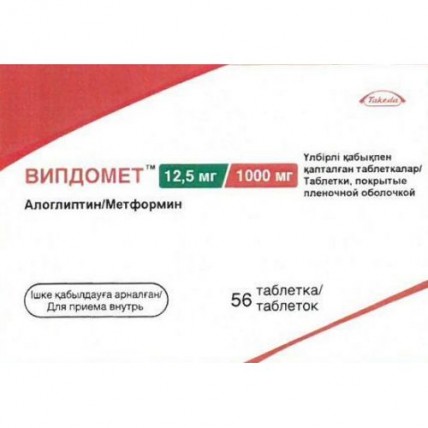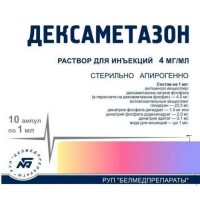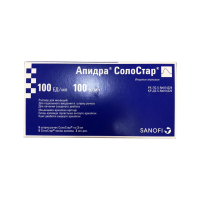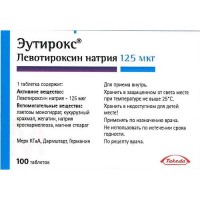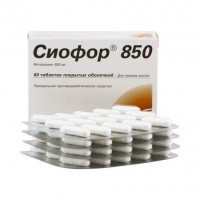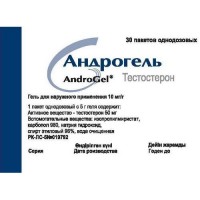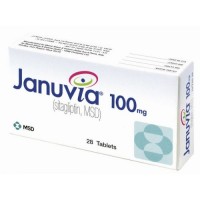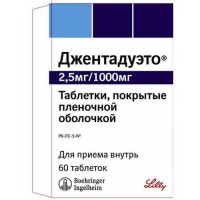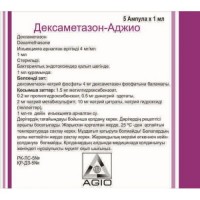Vipdomet® (Alogliptin/Metformin) 12.5 mg/1000 mg, 56 tablets
- $84.70
Sku:
3c6b9fa9d2ab
Brand:
Takeda (Germany)
Vipdomet® contains a combination of alogliptin and metformin. Alogliptin and metformin are oral diabetes medicines that help control blood sugar levels. Metformin works by decreasing glucose production in the liver and decreasing absorption of glucose by the intestines. Alogliptin works by regulating the levels of insulin your body produces after eating. Vipdomet® is used with diet and exercise to improve blood sugar control in adults with type 2 diabetes. Vipdomet® is not for treating type 1 diabetes.
Common brand names: Kazano
1 tablet 12.5 mg + 1000 mg contains:
Active ingredients: alogliptin benzoate 17 mg (in terms of alogliptin 12.5 mg), metformin hydrochloride 1000 mg.
Excipients:
Core: mannitol 70 mg, microcrystalline cellulose 96 mg, povidone K30 61 mg, crospovidone 66 mg, magnesium stearate 4 mg.
Film shell: hypromellose 2910 28 mg, talc 4.1 mg, titanium dioxide 3.86 mg, iron dye yellow oxide 0.04 mg.
Active substance
Alogliptin + Metformin
Type 2 diabetes mellitus (T2DM) in adult patients aged 18 years and older to improve glycemic control in addition to diet and exercise.
Monotherapy
In patients who have not achieved adequate glycemic control during monotherapy with metformin, or as a substitute for those who are already receiving combined treatment with metformin and alogliptin in the form of monotherapy.
Combination therapy
In combination with pioglitazone (triple combination: metformin + alogliptin + pioglitazone), when metformin and pioglitazone therapy does not lead to adequate glycemic control.
In combination with insulin (triple combination: metformin + alogliptin + insulin), when insulin and metformin therapy does not lead to adequate glycemic control.
- Hypersensitivity to alogliptin, or metformin, or to any excipient, or a history of serious hypersensitivity reactions to any DPP-4 inhibitor, including anaphylactic reactions, anaphylactic shock and angioedema;
- type 1 diabetes mellitus;
- any type of acute metabolic acidosis: lactic acidosis (including history), diabetic ketoacidosis;
- diabetic precoma, coma;
- Renal failure of moderate or severe degree (creatinine clearance (CC) less than 60 ml / min);
- acute conditions occurring with the risk of developing impaired renal function: dehydration (repeated vomiting, diarrhea); fever, severe infectious diseases; states of hypoxia (shock, sepsis, kidney infections, bronchopulmonary diseases);
- clinically pronounced manifestations of acute and chronic diseases / conditions that can lead to tissue hypoxia (including acute and chronic heart failure with unstable hemodynamic parameters, respiratory failure, acute myocardial infarction);
- liver failure, impaired liver function;
- acute alcohol intoxication, chronic alcoholism;
- compliance with a hypocaloric diet (less than 1000 kcal / day);
- use for less than 48 hours before and within 48 hours after carrying out radioisotope or X-ray studies with intravascular administration of an iodine-containing contrast agent (see the section "Interaction with other drugs");
- major surgical operations and trauma, when insulin therapy is indicated (see the section "Special instructions");
- pregnancy and the period of breastfeeding;
- the patient's age is up to 18 years due to the lack of data on efficacy and safety;
- combined use with sulfonylurea derivatives due to the lack of data on efficacy and safety (see the section "Special instructions").
Carefully:
- In patients over the age of 60, performing heavy physical work, which is associated with an increased risk of developing lactic acidosis in them (see the section "Special instructions");
- use of the drug Vipdomet in combination with pioglitazone (see the section "Special instructions");
- in patients with a history of pancreatitis.
The drug is taken orally.
Vipdomet should be taken 1 tablet 2 times a day at the same time as meals in order to reduce unwanted reactions from the gastrointestinal tract. The tablets should be swallowed whole, without chewing, with water.
If the patient missed taking the drug Vipdomet, he should take it immediately after remembering the missed dose of the drug. Do not take a double dose of Vipdomet at the same time; in this case, the dose should be skipped.
The dose of Vipdomet should be selected individually.
The frequency of adverse drug reactions is estimated as follows:
Very often: ≥1 / 10
Often: ≥ 1/100, <1/10
Uncommon: ≥ 1/1000, <1/100
Rarely: ≥ 1/10 000, <1/1000
Very rare: <1/10 000
The frequency has not been established (noted in the post-registration period).
Infectious and parasitic diseases:
Often: upper respiratory tract infections, nasopharyngitis.
Nervous system disorders:
Often: headache, taste disturbance - metallic taste in the mouth (for metformin).
Gastrointestinal disorders:
Very common (for metformin): abdominal pain, diarrhea, loss of appetite, nausea, vomiting.
Disorders from the gastrointestinal tract most often occur during the initial period of treatment and in most cases resolve spontaneously. To prevent symptoms, it is recommended to take the drug 2 times a day during or after meals.
Often: abdominal pain, gastroesophageal reflux disease, gastroenteritis, diarrhea, vomiting, gastritis.
Frequency not established (for alogliptin): acute pancreatitis.
Skin and subcutaneous tissue disorders:
Often: itching, rash.
Very rare (for metformin): erythema (redness of the skin), itching, urticaria.
Frequency not established (for alogliptin): exfoliative skin diseases, including Stevens-Johnson syndrome, erythema polymorphism, angioedema, urticaria.
Immune system disorders:
Frequency not established (for alogliptin): hypersensitivity reactions, including anaphylactic reaction.
Liver and biliary tract disorders:
Very rare (for metformin): impaired liver function and hepatitis.
Frequency not established (for alogliptin): impaired liver function, including liver failure.
Metabolic and nutritional disorders:
Often (for alogliptin): hypoglycemia when used together with drugs containing sulfonyl-urea or insulin.
Very rare (for metformin): lactic acidosis, vitamin B12 deficiency. With long-term use of metformin, there may be a decrease in the absorption of vitamin B12. When detecting megaloblastic anemia, it is necessary to take into account the possibility of such an etiology.
Vipdomet is a combination of two hypoglycemic agents with complementary and different mechanisms of action, designed to improve glycemic control in patients with type 2 diabetes mellitus: alogliptin, an inhibitor of the enzyme dipeptidyl peptidase-4 (DPP-4), and metformin, a representative of the biguanide class.
There are no data on overdose of the combined drug Vipdomet.
Alogliptin
The maximum dose of alogliptin used in clinical trials was 800 mg / day in healthy volunteers and 400 mg / day in patients with T2DM for 14 days. This is 32 and 16 times, respectively, the recommended daily dose of 25 mg of alogliptin.
There were no serious adverse events when taking the drug at these doses.
In case of overdose, gastric lavage and symptomatic treatment may be recommended.
Alogliptin is poorly dialyzed. In clinical studies, only 7% of the dose was removed from the body during a three hour hemodialysis session. There are no data on the effectiveness of peritoneal dialysis of alogliptin.
Metformin
A significant overdose or associated risk factors can lead to the development of lactic acidosis. If signs of lactic acidosis appear, treatment with the drug should be stopped immediately, the patient should be urgently hospitalized and, having determined the concentration of lactate, the diagnosis should be clarified. The most effective measure for removing lactate and metformin from the body is hemodialysis.
In case of an overdose of Vipdomet, in addition to the above methods of therapy, symptomatic treatment is carried out.
Application during pregnancy and lactation
Pregnancy
There are no data on the safety of using Vipdomet in pregnant women. Studies in pregnant rats have shown the reproductive toxicity of combination therapy with alogliptin and metformin when doses are administered approximately 5-20 times the recommended doses for humans (for metformin and alogliptin, respectively). The use of the drug Vipdomet during pregnancy is contraindicated.
Alogliptin
There are no data on the safety of using alogliptin in pregnant women. Animal studies have not shown any direct or indirect negative effects of alogliptin on the reproductive system.
Metformin
Limited evidence suggests that taking metformin in pregnant women does not increase the risk of developing birth defects in children. Animal studies have shown ns direct or indirect negative effects of metformin at clinically relevant doses on the reproductive system.
Breastfeeding period
There are no data on the penetration of alogliptin and metformin into breast milk in animals with combination therapy. When monotherapy with alogliptin or metformin, animal studies have shown that alogliptin and metformin pass into the milk of lactating rats.
There is no data on the penetration of alogliptin into human breast milk.
Metformin passes into breast milk in humans in small quantities, so the risk of side effects in infants cannot be excluded.
In this regard, the use of the drug during breastfeeding is contraindicated.
Influence on the ability to drive vehicles and mechanisms
The drug Vipdomet does not have or has a slight effect on the ability to drive vehicles and mechanisms. Nevertheless, it is necessary to take into account the risk of hypoglycemia when using the drug in combination with other hypoglycemic drugs (insulin or pioglitazone) and exercise caution when driving vehicles and mechanisms.
Lactic acidosis is a rare but serious (high mortality in the absence of urgent treatment) complication that can result from the accumulation of metformin. Cases of lactic acidosis while taking metformin occurred mainly in patients with diabetes mellitus with severe renal failure.
Other associated risk factors should also be considered, such as decompensated diabetes mellitus, ketosis, prolonged fasting, alcoholism, liver failure, and any condition associated with severe hypoxia. This can help reduce the incidence of lactic acidosis.
The risk of developing lactic acidosis should be considered when non-specific signs appear, such as muscle cramps, accompanied by dyspeptic disorders and / or abdominal pain and / or severe asthenia.
Lactic acidosis is characterized by acidotic dyspnea and hypothermia followed by coma. Diagnostic laboratory parameters are a decrease in blood pH (less than 7.25), plasma lactate concentration over 5 mmol / l, increased anion gap and lactate / pyruvate ratio. If you suspect lactic acidosis, you must stop taking the drug and immediately consult a doctor (see section "Overdose").
Kidney function
Alogliptin and metformin are primarily excreted by the kidneys. The risk of lactic acidosis associated with taking metformin increases as the degree of impaired renal function increases, therefore, creatinine clearance must be determined before starting treatment and regularly thereafter: at least once a year in patients with normal renal function, and 2-4 times a year in elderly patients, as well as in patients with creatinine clearance at the lower limit of the norm.
Special care should be taken for possible renal impairment in elderly patients with the simultaneous use of antihypertensive drugs, diuretics or non-steroidal anti-inflammatory drugs.
Liver failure
There are no clinical data on the use of Vipdomet in patients with severe hepatic impairment (more than 9 points on the Child-Pugh scale). The use of the drug in these groups of patients is not recommended.
Surgical operations
The use of metformin should be discontinued 48 hours before elective surgery and can be continued no earlier than 48 hours after, provided that during the examination, renal function was recognized as normal.
Use with other hypoglycemic drugs
Vipdomet is not recommended for use in combination with sulfonylurea derivatives, since safety and efficacy have not been studied.
In order to reduce the risk of hypoglycemia, it is recommended to reduce the dose of insulin and pioglitazone while using it with Vipdomet (see section "Dosage and Administration").
Changes in the clinical status of a patient with previously adequately controlled T2DM
If laboratory abnormalities or clinical symptoms of the disease appear in patients with previously adequately controlled DM2 during treatment with Vipdomet, patients should be immediately excluded, first of all, ketoacidosis or lactic acidosis based on the results of a blood test for electrolytes and ketones, plasma glucose concentration, and blood pH. the concentration of lactate and pyruvate, as well as the plasma concentration of metformin. With the development of acidosis of any etiology, further administration of the drug Vipdomet is canceled and measures are taken to correct the acidosis.
Acute pancreatitis
In a pooled analysis of 13 clinical trials using alogliptin at a dose of 25 mg / day, 12.5 mg / day, a reference drug and placebo, the incidence of acute pancreatitis was 2, 1, 1, or 0 cases per 1000 patient-years in each group, respectively. In a study of cardiovascular outcomes, the incidence of acute pancreatitis in patients treated with alogliptin or placebo was 3 and 2 cases per 1000 patient-years, respectively.
Patients should be informed about the characteristic symptoms of acute pancreatitis: persistent, severe abdominal pain that can radiate to the back.
If you suspect the development of acute pancreatitis, Vipdomet should be stopped; when confirming the development of acute pancreatitis, the drug is not resumed.
There is no data on whether there is an increased risk of developing pancreatitis while taking the drug alogliptin in patients with a history of pancreatitis. Therefore, patients with a history of pancreatitis should be used with caution.
Effects on liver function
There have been post-marketing reports of liver dysfunction, including liver failure, while taking alogliptin. Their relationship with the use of the drug has not been established. However, patients should be carefully examined for possible abnormal liver function tests. If abnormalities in liver function tests are found and an alternative etiology of their occurrence is not established, discontinuation of drug treatment should be considered.
Interaction
Alogliptin and Metformin
Simultaneous administration of alogliptin (100 mg once a day) and metformin hydrochloride (1000 mg twice a day) for 6 days in healthy volunteers was not accompanied by clinically significant changes in the pharmacokinetic parameters of alogliptin or metformin.
Studies of the pharmacokinetic interaction of Vipdomet with other drugs have not been carried out, further data on the interaction are given for each of the active substances of the drug separately.
The effect of other drugs on alogliptin
Alogliptin is mainly excreted unchanged by the kidneys and is only slightly metabolized by the cytochrome P450 enzyme system (CYP). Therefore, interactions with CYP inhibitors have not been observed and are not expected.
In clinical studies on the interaction with other drugs, the following drugs did not have a clinically significant effect on the pharmacokinetic parameters of alogliptin: gemfibrozil (an inhibitor of CYP2C8 / 9), fluconazole (an inhibitor of CYP2C9), ketoconazole (an inhibitor of CYP3A4), cyclosporin (an inhibitor of p-dose) glycoprotein (α-glycosidase inhibitor), digoxin, metformin, cimetidine, pioglitazone, and atorvastatin.
The effect of alogliptin on other drugs
In vitro studies have shown that alogliptin does not inhibit or induce CYP 450 isoforms at concentrations achieved with alogliptin at the recommended dose of 25 mg. Interactions with substrates of CYP 450 isoforms have not been observed and are not expected.
In vitro studies have shown that alogliptin is neither a substrate nor an inhibitor of OAT1, OAT3 or OCT2. In addition, data from clinical studies do not show interactions with inhibitors or substrates of β-glycoprotein.
In clinical studies on interaction with other drugs, alogliptin did not have a clinically significant effect on the pharmacokinetics of the following drugs: caffeine, (R) - and (S) -warfarin, pioglitazone, glibenclamide, tolbutamide, dextromethorphan, atorvastatin, midazolam, oral contraceptives ethinyl estradiol), digoxin, fexofenadine, metformin, or cimetidine.
Based on these data, alogliptin does not inhibit cytochrome isoenzymes CYP1A2, CYP3A4, CYP2D6, CYP2C9, p-glycoprotein and OCT2.
Alogliptin had no effect on the prothrombin index or the International Normalized Ratio (INR) in healthy volunteers when taken with warfarin.
The combination of alogliptin with other hypoglycemic drugs
Taking alogliptin in combination with metformin, or pioglitazone (thiazolidinedione), or an α-glycosidase inhibitor, or glibenclamide (a sulfonylurea derivative) did not show clinically significant pharmacokinetic interactions.
Metformin
Contraindicated combinations
Iodine-containing X-ray contrast agents: against the background of functional renal failure in patients with diabetes mellitus, radiological examination using iodine-containing X-ray contrast agents can cause the development of lactic acidosis. Taking Vipdomet should be discontinued depending on renal function 48 hours before or at the time of X-ray examination using iodine-containing X-ray contrast media and resumed no earlier than 48 hours after, provided that during the examination, renal function was recognized as normal.
Combinations not recommended
Alcohol: with acute alcohol intoxication, the risk of lactic acidosis increases, especially in the case of:
- inadequate nutrition (fasting), adherence to a low-calorie diet;
- liver failure.
You should avoid drinking alcohol and taking medications containing ethanol.
Cationic drugs (amiloride, digoxin, morphine, procainamide, quinidine, quinine, ranitidine, triamterene, trimethoprim and vancomycin, cimetidine) secreted in the renal tubules compete with metformin for tubular transport systems and can lead to an increase in its Cmax. It is recommended to carefully monitor glycemia and adjust the dose of Vipdomet and cationic drugs secreted by tubular secretion, in accordance with the recommended route of administration, in case of their simultaneous use.
Combinations requiring caution
Medicines with indirect hyperglycemic action, such as systemic and local glucocorticosteroids and tetracosactide, beta2-adrenomimetics, danazol, chlorpromazine when taken in high doses (100 mg per day) and diuretics: more frequent monitoring of blood glucose concentration may be required, especially at the beginning treatment. If necessary, the dose of Vipdomet can be adjusted during treatment and after its termination, based on glycemic indicators.
Certain drugs can have adverse effects on kidney function, which can increase the risk of lactic acidosis, such as non-steroidal anti-inflammatory drugs (NSAIDs), including selective cyclooxygenase II inhibitors and angiotensin II receptor antagonists. In the case of using these drugs in combination with metformin, it is necessary to carefully monitor renal function.
Antihypertensive drugs of the class of angiotensin-converting enzyme (ACE) inhibitors can reduce the concentration of glucose in the blood. If necessary, the dose of Vipdomet should be adjusted.
Diuretics: Concomitant use of loop diuretics can lead to the development of lactic acidosis due to possible functional renal failure. You should not prescribe the drug Vipdomet if the CC is below 60 ml / min.
With the simultaneous use of metformin with sulfonylurea derivatives, insulin, acarbose, salicylates, hypoglycemia may develop.
Nifedipine increases the absorption and Cmax of metformin.
The hypoglycemic effect of metformin can be reduced by phenothiazides, glucagon, estrogens, oral contraceptives, phenytoin, sympathomimetics, nicotinic acid, isoniazid, blockers of "slow" calcium channels, levothyroxine sodium.
Simultaneous use with cimetidine reduces the rate of elimination of metformin, which can lead to the development of lactic acidosis.
In healthy volunteers with the simultaneous use of metformin and propanolol, as well as with the use of metformin and ibuprofen, no changes in their pharmacokinetic parameters were observed.
Metformin can reduce the effect of indirect anticoagulants.
Transporter substrates for organic cations 1 and 2 (OST1 and OST2)
Metformin is a substrate for organic cations OCT1 and OCT2.
When used together with metformin:
- OCT1 inhibitors (such as verapamil) can reduce the hypoglycemic effect of metformin.
- OCT1 inducers (such as rifampicin) can increase the absorption of metformin in the gastrointestinal tract and enhance its hypoglycemic effect.
- OCT2 inhibitors (such as cimetidine, dolutegravir, ranolazine, trimethoprim, vandetanib, isavuconazole) can reduce renal excretion of metformin and lead to an increase in its concentration in blood plasma.
- OCT1 and OCT2 inhibitors (such as crizotinib, olaparid) can reduce the hypoglycemic effect of metformin.
Common brand names: Kazano
Composition
1 tablet 12.5 mg + 1000 mg contains:
Active ingredients: alogliptin benzoate 17 mg (in terms of alogliptin 12.5 mg), metformin hydrochloride 1000 mg.
Excipients:
Core: mannitol 70 mg, microcrystalline cellulose 96 mg, povidone K30 61 mg, crospovidone 66 mg, magnesium stearate 4 mg.
Film shell: hypromellose 2910 28 mg, talc 4.1 mg, titanium dioxide 3.86 mg, iron dye yellow oxide 0.04 mg.
Active substance
Alogliptin + Metformin
Indications for use
Type 2 diabetes mellitus (T2DM) in adult patients aged 18 years and older to improve glycemic control in addition to diet and exercise.
Monotherapy
In patients who have not achieved adequate glycemic control during monotherapy with metformin, or as a substitute for those who are already receiving combined treatment with metformin and alogliptin in the form of monotherapy.
Combination therapy
In combination with pioglitazone (triple combination: metformin + alogliptin + pioglitazone), when metformin and pioglitazone therapy does not lead to adequate glycemic control.
In combination with insulin (triple combination: metformin + alogliptin + insulin), when insulin and metformin therapy does not lead to adequate glycemic control.
Contraindications
- Hypersensitivity to alogliptin, or metformin, or to any excipient, or a history of serious hypersensitivity reactions to any DPP-4 inhibitor, including anaphylactic reactions, anaphylactic shock and angioedema;
- type 1 diabetes mellitus;
- any type of acute metabolic acidosis: lactic acidosis (including history), diabetic ketoacidosis;
- diabetic precoma, coma;
- Renal failure of moderate or severe degree (creatinine clearance (CC) less than 60 ml / min);
- acute conditions occurring with the risk of developing impaired renal function: dehydration (repeated vomiting, diarrhea); fever, severe infectious diseases; states of hypoxia (shock, sepsis, kidney infections, bronchopulmonary diseases);
- clinically pronounced manifestations of acute and chronic diseases / conditions that can lead to tissue hypoxia (including acute and chronic heart failure with unstable hemodynamic parameters, respiratory failure, acute myocardial infarction);
- liver failure, impaired liver function;
- acute alcohol intoxication, chronic alcoholism;
- compliance with a hypocaloric diet (less than 1000 kcal / day);
- use for less than 48 hours before and within 48 hours after carrying out radioisotope or X-ray studies with intravascular administration of an iodine-containing contrast agent (see the section "Interaction with other drugs");
- major surgical operations and trauma, when insulin therapy is indicated (see the section "Special instructions");
- pregnancy and the period of breastfeeding;
- the patient's age is up to 18 years due to the lack of data on efficacy and safety;
- combined use with sulfonylurea derivatives due to the lack of data on efficacy and safety (see the section "Special instructions").
Carefully:
- In patients over the age of 60, performing heavy physical work, which is associated with an increased risk of developing lactic acidosis in them (see the section "Special instructions");
- use of the drug Vipdomet in combination with pioglitazone (see the section "Special instructions");
- in patients with a history of pancreatitis.
Method of administration and dosage
The drug is taken orally.
Vipdomet should be taken 1 tablet 2 times a day at the same time as meals in order to reduce unwanted reactions from the gastrointestinal tract. The tablets should be swallowed whole, without chewing, with water.
If the patient missed taking the drug Vipdomet, he should take it immediately after remembering the missed dose of the drug. Do not take a double dose of Vipdomet at the same time; in this case, the dose should be skipped.
The dose of Vipdomet should be selected individually.
Side effects
The frequency of adverse drug reactions is estimated as follows:
Very often: ≥1 / 10
Often: ≥ 1/100, <1/10
Uncommon: ≥ 1/1000, <1/100
Rarely: ≥ 1/10 000, <1/1000
Very rare: <1/10 000
The frequency has not been established (noted in the post-registration period).
Infectious and parasitic diseases:
Often: upper respiratory tract infections, nasopharyngitis.
Nervous system disorders:
Often: headache, taste disturbance - metallic taste in the mouth (for metformin).
Gastrointestinal disorders:
Very common (for metformin): abdominal pain, diarrhea, loss of appetite, nausea, vomiting.
Disorders from the gastrointestinal tract most often occur during the initial period of treatment and in most cases resolve spontaneously. To prevent symptoms, it is recommended to take the drug 2 times a day during or after meals.
Often: abdominal pain, gastroesophageal reflux disease, gastroenteritis, diarrhea, vomiting, gastritis.
Frequency not established (for alogliptin): acute pancreatitis.
Skin and subcutaneous tissue disorders:
Often: itching, rash.
Very rare (for metformin): erythema (redness of the skin), itching, urticaria.
Frequency not established (for alogliptin): exfoliative skin diseases, including Stevens-Johnson syndrome, erythema polymorphism, angioedema, urticaria.
Immune system disorders:
Frequency not established (for alogliptin): hypersensitivity reactions, including anaphylactic reaction.
Liver and biliary tract disorders:
Very rare (for metformin): impaired liver function and hepatitis.
Frequency not established (for alogliptin): impaired liver function, including liver failure.
Metabolic and nutritional disorders:
Often (for alogliptin): hypoglycemia when used together with drugs containing sulfonyl-urea or insulin.
Very rare (for metformin): lactic acidosis, vitamin B12 deficiency. With long-term use of metformin, there may be a decrease in the absorption of vitamin B12. When detecting megaloblastic anemia, it is necessary to take into account the possibility of such an etiology.
Pharmachologic effect
Vipdomet is a combination of two hypoglycemic agents with complementary and different mechanisms of action, designed to improve glycemic control in patients with type 2 diabetes mellitus: alogliptin, an inhibitor of the enzyme dipeptidyl peptidase-4 (DPP-4), and metformin, a representative of the biguanide class.
Overdose
There are no data on overdose of the combined drug Vipdomet.
Alogliptin
The maximum dose of alogliptin used in clinical trials was 800 mg / day in healthy volunteers and 400 mg / day in patients with T2DM for 14 days. This is 32 and 16 times, respectively, the recommended daily dose of 25 mg of alogliptin.
There were no serious adverse events when taking the drug at these doses.
In case of overdose, gastric lavage and symptomatic treatment may be recommended.
Alogliptin is poorly dialyzed. In clinical studies, only 7% of the dose was removed from the body during a three hour hemodialysis session. There are no data on the effectiveness of peritoneal dialysis of alogliptin.
Metformin
A significant overdose or associated risk factors can lead to the development of lactic acidosis. If signs of lactic acidosis appear, treatment with the drug should be stopped immediately, the patient should be urgently hospitalized and, having determined the concentration of lactate, the diagnosis should be clarified. The most effective measure for removing lactate and metformin from the body is hemodialysis.
In case of an overdose of Vipdomet, in addition to the above methods of therapy, symptomatic treatment is carried out.
Application during pregnancy and lactation
Pregnancy
There are no data on the safety of using Vipdomet in pregnant women. Studies in pregnant rats have shown the reproductive toxicity of combination therapy with alogliptin and metformin when doses are administered approximately 5-20 times the recommended doses for humans (for metformin and alogliptin, respectively). The use of the drug Vipdomet during pregnancy is contraindicated.
Alogliptin
There are no data on the safety of using alogliptin in pregnant women. Animal studies have not shown any direct or indirect negative effects of alogliptin on the reproductive system.
Metformin
Limited evidence suggests that taking metformin in pregnant women does not increase the risk of developing birth defects in children. Animal studies have shown ns direct or indirect negative effects of metformin at clinically relevant doses on the reproductive system.
Breastfeeding period
There are no data on the penetration of alogliptin and metformin into breast milk in animals with combination therapy. When monotherapy with alogliptin or metformin, animal studies have shown that alogliptin and metformin pass into the milk of lactating rats.
There is no data on the penetration of alogliptin into human breast milk.
Metformin passes into breast milk in humans in small quantities, so the risk of side effects in infants cannot be excluded.
In this regard, the use of the drug during breastfeeding is contraindicated.
Influence on the ability to drive vehicles and mechanisms
The drug Vipdomet does not have or has a slight effect on the ability to drive vehicles and mechanisms. Nevertheless, it is necessary to take into account the risk of hypoglycemia when using the drug in combination with other hypoglycemic drugs (insulin or pioglitazone) and exercise caution when driving vehicles and mechanisms.
Special instructions
Lactic acidosis is a rare but serious (high mortality in the absence of urgent treatment) complication that can result from the accumulation of metformin. Cases of lactic acidosis while taking metformin occurred mainly in patients with diabetes mellitus with severe renal failure.
Other associated risk factors should also be considered, such as decompensated diabetes mellitus, ketosis, prolonged fasting, alcoholism, liver failure, and any condition associated with severe hypoxia. This can help reduce the incidence of lactic acidosis.
The risk of developing lactic acidosis should be considered when non-specific signs appear, such as muscle cramps, accompanied by dyspeptic disorders and / or abdominal pain and / or severe asthenia.
Lactic acidosis is characterized by acidotic dyspnea and hypothermia followed by coma. Diagnostic laboratory parameters are a decrease in blood pH (less than 7.25), plasma lactate concentration over 5 mmol / l, increased anion gap and lactate / pyruvate ratio. If you suspect lactic acidosis, you must stop taking the drug and immediately consult a doctor (see section "Overdose").
Kidney function
Alogliptin and metformin are primarily excreted by the kidneys. The risk of lactic acidosis associated with taking metformin increases as the degree of impaired renal function increases, therefore, creatinine clearance must be determined before starting treatment and regularly thereafter: at least once a year in patients with normal renal function, and 2-4 times a year in elderly patients, as well as in patients with creatinine clearance at the lower limit of the norm.
Special care should be taken for possible renal impairment in elderly patients with the simultaneous use of antihypertensive drugs, diuretics or non-steroidal anti-inflammatory drugs.
Liver failure
There are no clinical data on the use of Vipdomet in patients with severe hepatic impairment (more than 9 points on the Child-Pugh scale). The use of the drug in these groups of patients is not recommended.
Surgical operations
The use of metformin should be discontinued 48 hours before elective surgery and can be continued no earlier than 48 hours after, provided that during the examination, renal function was recognized as normal.
Use with other hypoglycemic drugs
Vipdomet is not recommended for use in combination with sulfonylurea derivatives, since safety and efficacy have not been studied.
In order to reduce the risk of hypoglycemia, it is recommended to reduce the dose of insulin and pioglitazone while using it with Vipdomet (see section "Dosage and Administration").
Changes in the clinical status of a patient with previously adequately controlled T2DM
If laboratory abnormalities or clinical symptoms of the disease appear in patients with previously adequately controlled DM2 during treatment with Vipdomet, patients should be immediately excluded, first of all, ketoacidosis or lactic acidosis based on the results of a blood test for electrolytes and ketones, plasma glucose concentration, and blood pH. the concentration of lactate and pyruvate, as well as the plasma concentration of metformin. With the development of acidosis of any etiology, further administration of the drug Vipdomet is canceled and measures are taken to correct the acidosis.
Acute pancreatitis
In a pooled analysis of 13 clinical trials using alogliptin at a dose of 25 mg / day, 12.5 mg / day, a reference drug and placebo, the incidence of acute pancreatitis was 2, 1, 1, or 0 cases per 1000 patient-years in each group, respectively. In a study of cardiovascular outcomes, the incidence of acute pancreatitis in patients treated with alogliptin or placebo was 3 and 2 cases per 1000 patient-years, respectively.
Patients should be informed about the characteristic symptoms of acute pancreatitis: persistent, severe abdominal pain that can radiate to the back.
If you suspect the development of acute pancreatitis, Vipdomet should be stopped; when confirming the development of acute pancreatitis, the drug is not resumed.
There is no data on whether there is an increased risk of developing pancreatitis while taking the drug alogliptin in patients with a history of pancreatitis. Therefore, patients with a history of pancreatitis should be used with caution.
Effects on liver function
There have been post-marketing reports of liver dysfunction, including liver failure, while taking alogliptin. Their relationship with the use of the drug has not been established. However, patients should be carefully examined for possible abnormal liver function tests. If abnormalities in liver function tests are found and an alternative etiology of their occurrence is not established, discontinuation of drug treatment should be considered.
Interaction
Alogliptin and Metformin
Simultaneous administration of alogliptin (100 mg once a day) and metformin hydrochloride (1000 mg twice a day) for 6 days in healthy volunteers was not accompanied by clinically significant changes in the pharmacokinetic parameters of alogliptin or metformin.
Studies of the pharmacokinetic interaction of Vipdomet with other drugs have not been carried out, further data on the interaction are given for each of the active substances of the drug separately.
The effect of other drugs on alogliptin
Alogliptin is mainly excreted unchanged by the kidneys and is only slightly metabolized by the cytochrome P450 enzyme system (CYP). Therefore, interactions with CYP inhibitors have not been observed and are not expected.
In clinical studies on the interaction with other drugs, the following drugs did not have a clinically significant effect on the pharmacokinetic parameters of alogliptin: gemfibrozil (an inhibitor of CYP2C8 / 9), fluconazole (an inhibitor of CYP2C9), ketoconazole (an inhibitor of CYP3A4), cyclosporin (an inhibitor of p-dose) glycoprotein (α-glycosidase inhibitor), digoxin, metformin, cimetidine, pioglitazone, and atorvastatin.
The effect of alogliptin on other drugs
In vitro studies have shown that alogliptin does not inhibit or induce CYP 450 isoforms at concentrations achieved with alogliptin at the recommended dose of 25 mg. Interactions with substrates of CYP 450 isoforms have not been observed and are not expected.
In vitro studies have shown that alogliptin is neither a substrate nor an inhibitor of OAT1, OAT3 or OCT2. In addition, data from clinical studies do not show interactions with inhibitors or substrates of β-glycoprotein.
In clinical studies on interaction with other drugs, alogliptin did not have a clinically significant effect on the pharmacokinetics of the following drugs: caffeine, (R) - and (S) -warfarin, pioglitazone, glibenclamide, tolbutamide, dextromethorphan, atorvastatin, midazolam, oral contraceptives ethinyl estradiol), digoxin, fexofenadine, metformin, or cimetidine.
Based on these data, alogliptin does not inhibit cytochrome isoenzymes CYP1A2, CYP3A4, CYP2D6, CYP2C9, p-glycoprotein and OCT2.
Alogliptin had no effect on the prothrombin index or the International Normalized Ratio (INR) in healthy volunteers when taken with warfarin.
The combination of alogliptin with other hypoglycemic drugs
Taking alogliptin in combination with metformin, or pioglitazone (thiazolidinedione), or an α-glycosidase inhibitor, or glibenclamide (a sulfonylurea derivative) did not show clinically significant pharmacokinetic interactions.
Metformin
Contraindicated combinations
Iodine-containing X-ray contrast agents: against the background of functional renal failure in patients with diabetes mellitus, radiological examination using iodine-containing X-ray contrast agents can cause the development of lactic acidosis. Taking Vipdomet should be discontinued depending on renal function 48 hours before or at the time of X-ray examination using iodine-containing X-ray contrast media and resumed no earlier than 48 hours after, provided that during the examination, renal function was recognized as normal.
Combinations not recommended
Alcohol: with acute alcohol intoxication, the risk of lactic acidosis increases, especially in the case of:
- inadequate nutrition (fasting), adherence to a low-calorie diet;
- liver failure.
You should avoid drinking alcohol and taking medications containing ethanol.
Cationic drugs (amiloride, digoxin, morphine, procainamide, quinidine, quinine, ranitidine, triamterene, trimethoprim and vancomycin, cimetidine) secreted in the renal tubules compete with metformin for tubular transport systems and can lead to an increase in its Cmax. It is recommended to carefully monitor glycemia and adjust the dose of Vipdomet and cationic drugs secreted by tubular secretion, in accordance with the recommended route of administration, in case of their simultaneous use.
Combinations requiring caution
Medicines with indirect hyperglycemic action, such as systemic and local glucocorticosteroids and tetracosactide, beta2-adrenomimetics, danazol, chlorpromazine when taken in high doses (100 mg per day) and diuretics: more frequent monitoring of blood glucose concentration may be required, especially at the beginning treatment. If necessary, the dose of Vipdomet can be adjusted during treatment and after its termination, based on glycemic indicators.
Certain drugs can have adverse effects on kidney function, which can increase the risk of lactic acidosis, such as non-steroidal anti-inflammatory drugs (NSAIDs), including selective cyclooxygenase II inhibitors and angiotensin II receptor antagonists. In the case of using these drugs in combination with metformin, it is necessary to carefully monitor renal function.
Antihypertensive drugs of the class of angiotensin-converting enzyme (ACE) inhibitors can reduce the concentration of glucose in the blood. If necessary, the dose of Vipdomet should be adjusted.
Diuretics: Concomitant use of loop diuretics can lead to the development of lactic acidosis due to possible functional renal failure. You should not prescribe the drug Vipdomet if the CC is below 60 ml / min.
With the simultaneous use of metformin with sulfonylurea derivatives, insulin, acarbose, salicylates, hypoglycemia may develop.
Nifedipine increases the absorption and Cmax of metformin.
The hypoglycemic effect of metformin can be reduced by phenothiazides, glucagon, estrogens, oral contraceptives, phenytoin, sympathomimetics, nicotinic acid, isoniazid, blockers of "slow" calcium channels, levothyroxine sodium.
Simultaneous use with cimetidine reduces the rate of elimination of metformin, which can lead to the development of lactic acidosis.
In healthy volunteers with the simultaneous use of metformin and propanolol, as well as with the use of metformin and ibuprofen, no changes in their pharmacokinetic parameters were observed.
Metformin can reduce the effect of indirect anticoagulants.
Transporter substrates for organic cations 1 and 2 (OST1 and OST2)
Metformin is a substrate for organic cations OCT1 and OCT2.
When used together with metformin:
- OCT1 inhibitors (such as verapamil) can reduce the hypoglycemic effect of metformin.
- OCT1 inducers (such as rifampicin) can increase the absorption of metformin in the gastrointestinal tract and enhance its hypoglycemic effect.
- OCT2 inhibitors (such as cimetidine, dolutegravir, ranolazine, trimethoprim, vandetanib, isavuconazole) can reduce renal excretion of metformin and lead to an increase in its concentration in blood plasma.
- OCT1 and OCT2 inhibitors (such as crizotinib, olaparid) can reduce the hypoglycemic effect of metformin.
